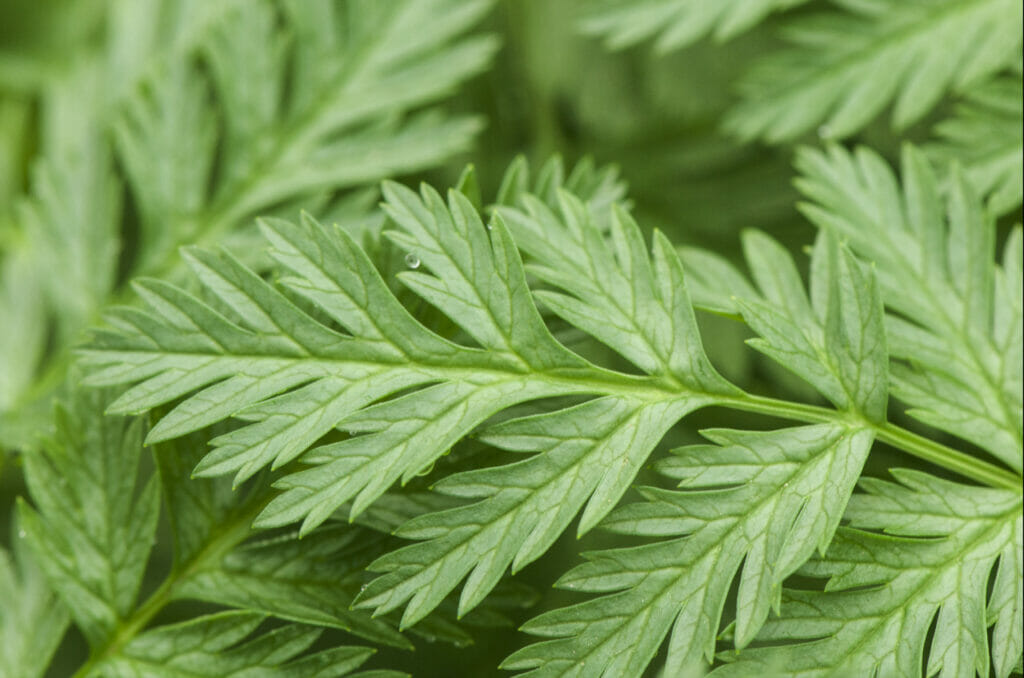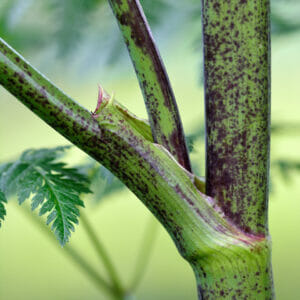Whilst a lot of emphasis is placed on the control of UK non-native invasive plant species, some plants deserve to be on the ‘watch-list’ for different reasons. In the case of hemlock (Conium maculatum), commonly known as wild or poison hemlock, it is native to the British Isles as it is not considered to be invasive. However, it is so highly poisonous that steps should be taken to avoid it and, where it arises in an inappropriate location the plant should be safely dealt with. Whilst every part of the plant is poisonous, wild hemlock leaves are the part most likely to be ingested. One partial safeguard, is provided by the horrible odour hemlock leaves give off when crushed.
Hemlock is Pretty, Pungent and Poisonous
Important to note – it not recommend to try to tackle controlling hemlock unless they are fully prepared with the correct protective equipment, and have a thorough understanding of the risks associated with handling the plant. The proper facilities facilities will also be required to store any waste safely to ensure that will not harm others.
If you think you have hemlock poisoning or you can see the signs of it in someone else, call for medical assistance immediately. If the affected person is close to an A & E department, get them there as quickly as possible. If possible, take a sample of the plant for identification. Do not try and make the patient sick. Someone with hemlock poisoning can usually be successfully treated in a hospital. Do not attempt to treat a case of hemlock poisoning at home, as symptoms can worsen rapidly.
All parts of the hemlock plant are highly poisonous to both humans and animals. The most notable toxin in hemlock is coniine. The effects of hemlock poisoning are extremely serious, appearing 20 minutes to 3 hours after ingestion. In humans, the poison affects the nervous and respiratory systems, with symptoms including muscle tremors/pain and feeling weak, a burning sensation from the throat to the stomach, dilated pupils and increased saliva production, which can be followed very quickly by a slowing of the heart rate, speech loss, convulsions, unconsciousness and death.
Many people will get a painful rash from getting poison hemlock sap on their skin. If the sap gets into the eyes, it will produce a very painful burning sensation.
Identifying hemlock in the UK
Fortunately, poison hemlock gives off a pretty unpleasant smell, especially when crushed. Many people describe the smell as musty or mousey. Unfortunately, this doesn’t occur throughout the whole lifecycle, so even this isn’t a foolproof way of identifying the plant. The other thing to note is that, as a member of the umbellifer family of plants, there are many other species that have similar characteristics, including some edible plants.
If you are not experienced in plant identification, the best way to deal with umbellifers is ‘look but don’t touch’; alongside the edibles, there are just as many poisonous umbellifers. To add to the confusion, the names of many of these plants can be quite similar; for example, the most poisonous plant in the British Isles and a common sight on our waterways is hemlock water dropwort (yes, it’s even deadlier than ‘regular’ hemlock).
Physical characteristics of hemlock include an ability to grow to 2.5 metres (that’s well over 8 foot) although 1.5 metres is a more typical height. The hollow stems are smooth and hairless (in fact the whole plant is hairless) but grooved and, for most of the lifecycle will include red or purple blotches, spots or streaks. At the base of each leaf stem there will be a sheath or ‘wrap’ that encircles the main stem. The leaves are sometimes described as fern-like, as they are heavily divided, giving them a light and feathery appearance. Taken as a whole, the leaf shape can be said to be like a long triangle. The leaves will be symmetrical along the centre line, may be up to 50 cm long and nearly as wide.

Poison hemlock leaves | Photo 182370219 / Hemlock Plant © Juan Francisco Moreno GÁmez | Dreamstime.com
The small, white flowers of conium maculatum grow in umbrella-like clusters from a loose spray of slender stems at the top of the main stems. The flowers will have five petals and will ripen into tiny green seeds that turn brown as they mature.
Hemlock stems and leaves grow from a tap root that bears a resemblance to parsnip root (it’s normally not so evenly shaped though). It goes without saying that eating hemlock root is a very bad idea as it contains the alkaloid poison coniine like the rest of the plant.

Photo 63953204 / Hemlock Plant © Ian Redding | Dreamstime.com
It’s important to know that hemlock is a biennial, meaning that in its first year of life, the plant will not grow to its full height and won’t bear any flowers as these only occur in the second season.
Hemlock generally will be visible between the months of March and September. After the growth season (both years), hemlock leaves and stems die back and become yellow and brown, turning brittle and dry in the process.
You’d think that once the plant had decayed away to dried-out fragments the problems associated with its toxicity would disappear but, unfortunately, this isn’t the case; some studies have found that the stem remnants will remain toxic for three years after dying back.
How and why to control poison hemlock
Hemlock, sometimes known as wild hemlock, is quite a common plant throughout southern England, becoming more scarce the further north you travel. It is common to see hemlock plants growing along roadsides and pathways. Although, it has a preference for damp soils near ponds and waterways, The plant is also not averse to sneaking out and taking up residence in gardens.
If you identify poison hemlock growing on your property, it would be wise to get it removed or killed as quickly as possible. Most importantly, you’ll want to prevent the plant from seeding* and exacerbating the problem.
If you live near to a public open space or to agricultural land used for pasture, it’s doubly important to prevent the spread of hemlock – the poisons held in the stems, roots, leaves, flowers and seeds are just as lethal to livestock as they are to humans.
If you decide to tackle the poison hemlock weed control yourself, make sure you do your research thoroughly and get kitted up for the work to help prevent injury or poisoning from happening. However, it is sensible to seek professional help to get rid of hemlock on your property. At PBA Solutions, our UK hemlock control service is conducted by invasive weed specialists and includes full removal of the toxic waste from site.
Depending on the situation and context, we can either physically remove the plants in their entirety or conduct herbicide treatments using professional standard equipment and chemicals. All of our technicians are trained and experienced, so you can be assured that we will use chemicals safely and appropriately.
PBA Solutions is an established company specialising in non-native invasive plant species. We’re here to help if you need to remove or control poison hemlock in a UK garden.
Just call 0203 174 2187 or 01202 816134 to talk to one of our consultants.
Lead page image | Photo 193461511 / Hemlock Plant © Nenad Nedomacki | Dreamstime.com

